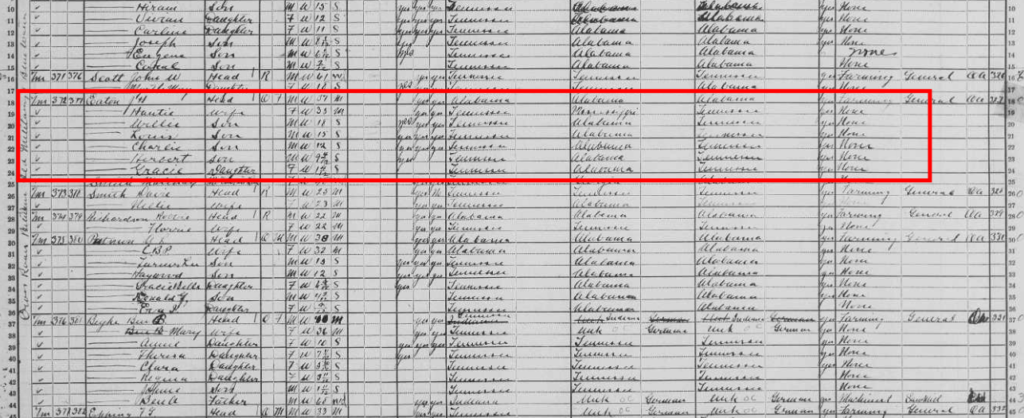
The 1920 U.S. Census was very similar to the 1910 U.S. Census. A few questions were eliminated from the previous census and few new ones added. The census day moved from April to January 1st with the thought that more people would be at home. This census included a schedule for agriculture and animals to be taken every 10 years. A manufacturing schedule was to be taken every 2 years.
This census required that a person be recorded with their usual abode. If a person was traveling away from their home, they were supposed to be recorded with their family. Service men, transients and migrant workers were recorded where they were currently living even if it was not their usual abode.
The purpose of the census in the United States is to determine representation. However Congress had never figured out a consistent way to assign that representation based on the population. Reapportionment of representatives did not happen after the 1920 U.S. census because Congress failed to agree on a method. Reapportionment happened after the 1930 U.S. census with the passage of the Reapportionment Act of 1929. (Census Bureau)
Table of Contents
Questions for the 1920 U.S. Census
The FamilySearch Research Wiki provides an overview of the questions that were asked. Many of the questions from the 1910 U.S. census carried over to the 1920 census. The overall format and style of the census enumeration sheets was also similar.
The questions on years of marriage and number of children born/living were eliminated. The question about Civil War veterans was also eliminated. Instead more specific questions were asked about immigration, naturalization, place of birth, and languages.
Economic questions were asked about families homes, such as rented or owned, but not about unemployment. Individuals were asked again about their occupation and industry.
Missing Records
According to FamilySearch, all states and several territories were included in the census count. It is possible there are missing records. The enumeration sheets were microfilmed in the 1950s after which the originals were destroyed. The original microfilming is not of high quality so some enumeration sheets are difficult to read.
Statistics
The 1920 U.S. census was the first to record more people living in urban rather than rural areas. The overall population increased about 15% to 106,021,537. The most populous state was New York and the least populous was Nevada. The most populous cities were New York City, Chicago, and Philadelphia with New York City having a population over 5 million people. (Wikipedia).
A look at John Henry Eaton in 1920

John Henry Eaton’s family continued to grow between 1910 and 1920.
| Name | Relationship | Sex | Age |
| Eaton, J. H. | Head | M | 37 |
| Hautie | Wife | F | 35 |
| Willie | Son | M | 18 |
| Louis | Son | M | 15 |
| Charlie | Son | M | 12 |
| Herbert | Son | M | 9 |
| Gracie | Daughter | F | 1 |
| Smith, Malindy | Mother-in-law | F | 58 |
Three more children were born to John Henry and Hautie – Herbert, Carrie Leota, and Gracie. Carrie died in 1917 as an infant and was thus not in the 1920 U.S. census. There were a total of 5 living children. There was also quite an age spread between the oldest child Willie and the youngest Gracie of about 18 years.
The Eaton’s were living in a home they owned free of a mortgage. John Henry was working as a farmer on his own account, in other words self-employed. This is quite a change from their previous circumstances in 1910 where they were living in a rented home after an extended period of unemployment.

Also living in the home is Hautie’s mother Malindy Smith, age 58 years old. Next door is Hautie’s brother Davie Smith with his wife. Davie was also farming, so it is possible that John Henry and Davie helped each other with their farms.
Sources
- 1920 U.S. Census, Lawrence, Tennessee, population schedule, township 2nd District, enumeration district (ED) 84, sheet 22A (penned), dwelling 372, family 377, J. H. Eaton; digital image, FamilySearch, (https://www.familysearch.org/ark:/61903/1:1:MNP6-YZV accessed 14 June 2023); citing NARA microfilm publication T625, roll 1752.







3 responses to “A good look at the 1920 U.S. Census”
Hi! Thank you for this post. You mention “ The Eaton’s were living in a home they owned free of a mortgage”
Can you share how you’re able to decipher that they didn’t have a mortgage?
Thanks!
Yes! It is on the 1920 census. Under the Tenure column it shows they lived in an owned home, free of a mortgage. The family was known to be very poor so it is not clear how they were able to do this. If it is true there should be property records. Something that needs more research!
[…] 1930 U.S. census is similar to the previous census of 1920. Some questions were dropped or modified and a few new questions were added. In the time between […]